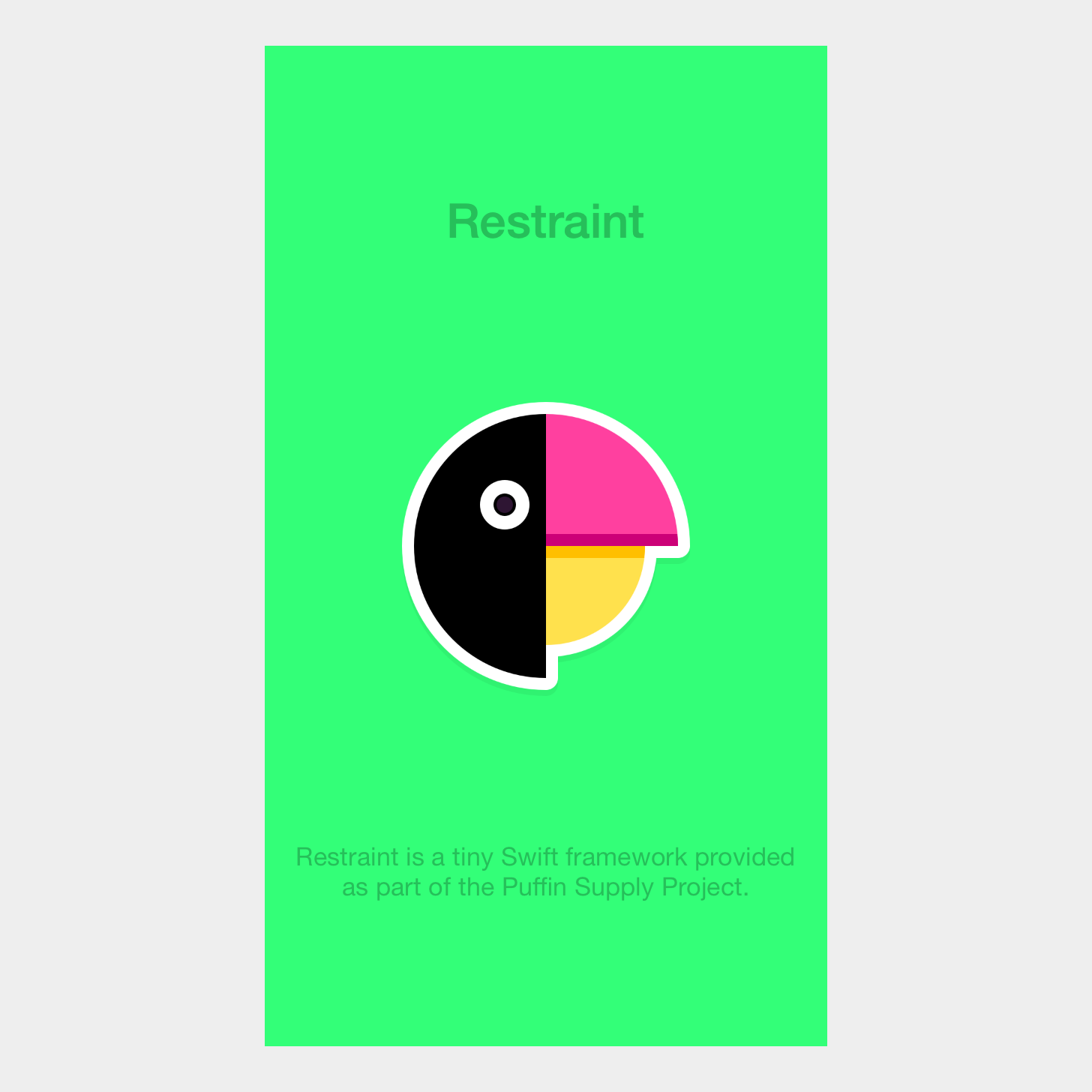Restraint is a very very small library to help make your use of NSLayoutConstraint in Swift more legible & declarative.
- Like programmatic views?
- Like the benefits of using pure AutoLayout?
- Like clear and minimal interfaces?
- Dislike Visual Format Language and "stringly" typing?
- Dislike the verbosity of
NSLayoutConstraint? - Dislike heavy dependencies?
- Practice
Restraint!
- As simple as possible
- Easy to maintain
- Easy to replace
- Easy to circumvent
- Not too clever
- Sane defaults
- Automatic handling of
setTranslatesAutoresizingMaskIntoConstraints
Let's set the height & width of an imageView to 200 points and center in the current UIView. Here's how we would do that with NSLayoutConstraint:
let imageViewWidthConstraint = NSLayoutConstraint(
item: imageView,
attribute: .Height,
relatedBy: .Equal,
toItem: nil,
attribute: .NotAnAttribute,
multiplier: 1.0,
constant: 200
)
let imageViewHeightConstraint = NSLayoutConstraint(
item: imageView,
attribute: .Width,
relatedBy: .Equal,
toItem: nil,
attribute: .NotAnAttribute,
multiplier: 1.0,
constant: 200
)
imageView.addConstraints([imageViewWidthConstraint, imageViewHeightConstraint])
let imageViewHorizontalConstraint = NSLayoutConstraint(
item: imageView,
attribute: .CenterX,
relatedBy: .Equal,
toItem: self,
attribute: .CenterX,
multiplier: 1.0,
constant: 0
)
let imageViewVerticalConstraint = NSLayoutConstraint(
item: imageView,
attribute: .CenterY,
relatedBy: .Equal,
toItem: self,
attribute: .CenterY,
multiplier: 1.0,
constant: 0
)
addConstraints([imageViewHorizontalConstraint, imageViewVerticalConstraint])And of course, this depends upon your particular formatting conventions. You know how quickly this gets out of hand.
Here's how to apply these same constraints with Restraint:
Restraint(imageView, .Width, .Equal, 200).addToView(imageView)
Restraint(imageView, .Height, .Equal, 200).addToView(imageView)
Restraint(imageView, .CenterX, .Equal, self, .CenterX).addToView(self)
Restraint(imageView, .CenterY, .Equal, self, .CenterY).addToView(self)For this view, we'd like to:
- Center the
imageView(which is of a fixed size) vertically and horizontally in the containing view. - Center
topLabel(which is of a variable size) vertically between the top ofimageViewand the top of the containing view. - Center
topLabelhorizontally in the containing view. - Center
bottomLabel(which is of a variable size) vertically between the bottom ofimageViewand the bottom of the containing view. - Set the width of
bottomLabelto the width of the containing view less its layout margins.
Here are those rules expressed with Restraint:
// Image View Constraints
Restraint(imageView, .Width, .Equal, imageViewSize).addToView(self)
Restraint(imageView, .Height, .Equal, imageViewSize).addToView(self)
Restraint(imageView, .CenterX, .Equal, self, .CenterX).addToView(self)
Restraint(imageView, .CenterY, .Equal, self, .CenterY).addToView(self)
// Top Label Constraints
Restraint(topLabel, .CenterX, .Equal, imageView, .CenterX).addToView(self)
Restraint(topLabel, .CenterY, .Equal, imageView, .Top, 0.5, 0).addToView(self)
// Bottom Label Constraints
Restraint(bottomLabel, .Left, .Equal, self, .LeftMargin).addToView(self)
Restraint(bottomLabel, .Right, .Equal, self, .RightMargin).addToView(self)
Restraint(bottomLabel, .CenterY, .Equal, self, .CenterY, 1.5, (200 / 4)).addToView(self)You can see this in action in Example/View.swift
Each Restraint simply creates the appropriate NSLayoutConstraint, and the call to addToView disables translatesAutoresizingMaskIntoConstraints on the left view in the constraint and adds that constraint to the target view.
Optionally, you can call Restraint().constraint() to get an instance of NSLayoutConstraint and add your constraint with UIView#addConstraint or #addConstraints later. For example:
let heightConstraint = Restraint(imageView, .Height, .Equal, 200).constraint()
imageView.addConstraint(heightConstraint)In this case you'll need to handle disabling translatesAutoresizingMaskIntoConstraints yourself.
Add the following to your project's Cartfile:
github "puffinsupply/Restraint" >= 1.0Simply add Restraint.swift to your project.

